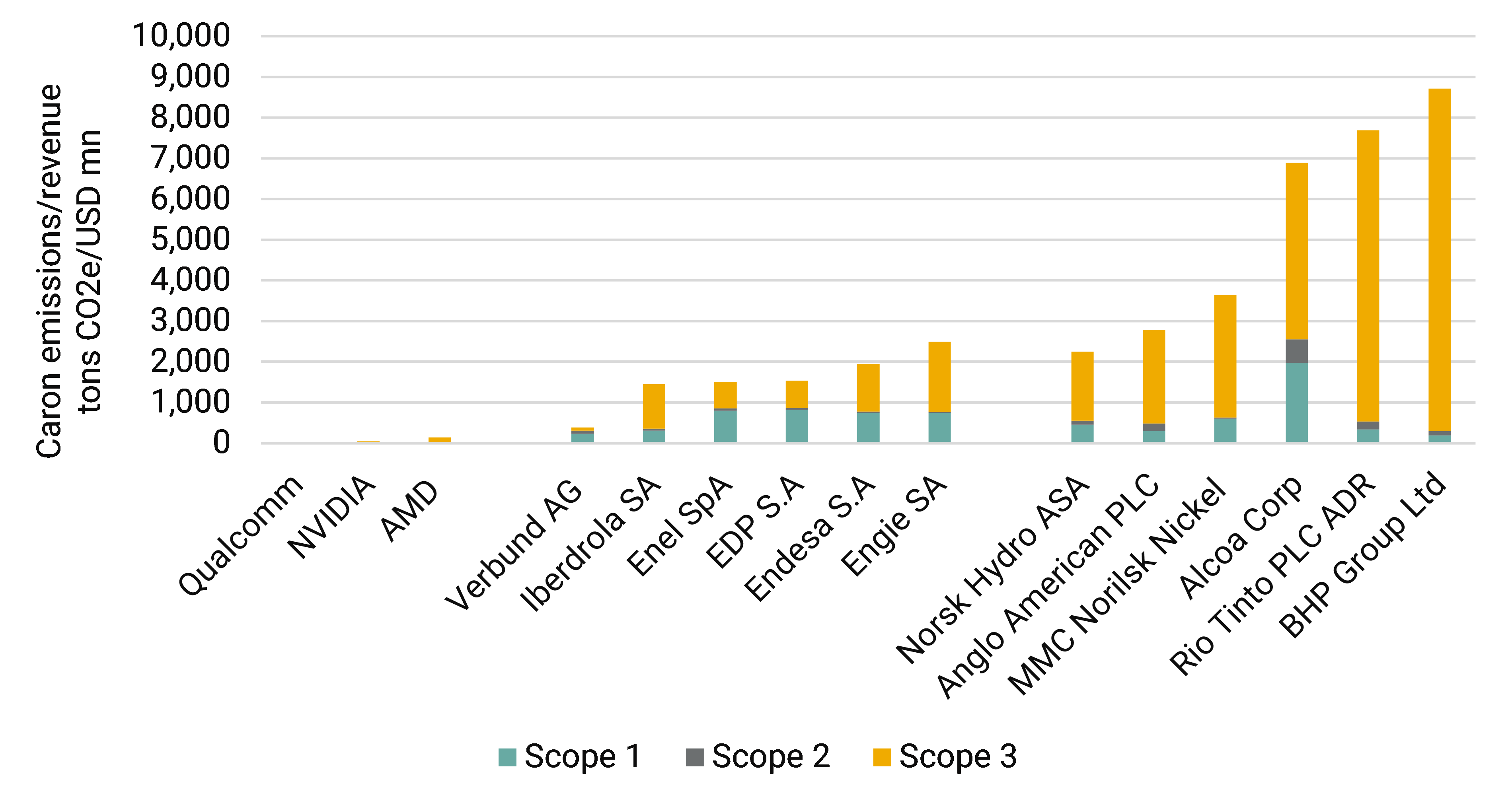In this year’s recent thematic research report by Sustainalytics, An ESG Lens on Blockchain and Public Equities, we assessed how a small but growing number of companies in resource-intensive industries, such as utilities, mining and semiconductor manufacturing, are developing blockchain solutions as part of their strategy to address environmental risks related to carbon emissions, water withdrawal, and responsible sourcing.
One application of blockchain technology is for the tracking of carbon emissions across supply chains using smart sensors and Internet of Things (IoT) technology. Blockchain supply chain tracking systems help quantify and record energy consumption data, providing more accurate and standardized measurements than those obtained by other means. The use of blockchain technology may also help secure data related platforms and improve the transparency, accountability and traceability of emissions.[1]
Exhibit 1 shows the greenhouse gas emissions intensity (tonnes of CO2e per million dollars of revenue) of a selection of companies that are developing blockchain tools in the mining, utility and semiconductor industries.[2] Scope 1 emissions represent direct emissions from each company; scope 2 emissions signify indirect emissions; scope 3 emissions encompass all emissions that originate not from the company itself but from its extended value chain.[3]
Exhibit 1: GHG emissions intensity for mining, utility and semiconductor fabrication companies

While all the companies in this sample are developing technology to address issues related to emissions or supply chain management, their approaches to integrating blockchain and their carbon emission intensity vary substantially. Overall, emissions from mining companies are significantly higher than those from other industries in this sample, followed by utilities and semiconductor companies. Mining companies’ scope 3 emissions are substantially above the norm, owing largely to supply chain logistics and the use of metals in making intermediate and end products.
While blockchain technology is in the early phase of implementation in the metals and mining industry, most miners in our sample are using it to improve the transparency and traceability of their supply chains in relation to carbon emissions, which can, in turn, help customers make informed purchase decisions. For example, Norsk Hydro has the lowest carbon intensity among its sampled peers and uses blockchain technology to produce sustainable aluminum certifications that track emissions data. The technology aids in measuring and reporting the use of recycled aluminum, which contains a minimum of 75% recycled post-consumer aluminum scrap; this takes significantly less energy to produce than traditional aluminum but retains the high quality of the original metal.[4]
Though utility companies in the sample have lower emissions than those in the metal mining industry, those with a higher proportion of high-carbon-emitting generation also have significantly higher scope 1 and scope 3 emissions than their peers. With the accelerated transition from traditional fuels to renewables, utilities are leveraging blockchain technology within their operations and supply chains for various uses, such as verifying renewable energy certifications, building decentralized energy trading systems, optimizing electric vehicle (EV) charging stations and digitizing energy markets. For instance, Verbund AG applies a distributed ledger technology to help wholesale customers trade electricity via a blockchain-based app for Android, which reportedly reduces consumers’ bills by approximately 40%.[5] As well as adding trading flexibility and cost savings, blockchain technology eliminates dependency on intermediaries in the system, helping to build a stronger supplier-client relationship.
Semiconductor companies generally have lower carbon intensity than utilities and mining companies. However, the overall carbon footprint from manufacturing semiconductor chips is large. This issue poses significant environmental risks, especially in jurisdictions with strengthening carbon regulations.[6] Among the fabless semiconductor companies in our sample, Qualcomm has the lowest carbon intensity. The company reports that global deployment of 5G technology could contribute as much as a 6% reduction in annual US emissions from base year the 2020 by 2025.[7] The adoption of blockchain resolves issues of data security and scalability faced by 5G-enabled IoT systems. Qualcomm also reports that 5G can help with the efficient monitoring of energy consumption, enabling better emissions reduction from devices produced by the information and communications technology sector.[8]
Looking ahead to the future of blockchain and climate solutions
From our deep dive into blockchain applications, we found that companies investing in this technology may benefit from reduced emissions, lower operating expenses and improved efficiencies.
While the above analysis applies Sustainalytics’ carbon intensity metric to compare company performances across three industries developing blockchain solutions, investors may look into companies across different industries responding to tightening carbon regulations using distributed ledger technology.
Learn more about blockchain’s role in mitigating ESG risks in various industries in Sustainalytics’ 2022 thematic report 2022: An ESG lens on blockchain and public equities.
Sources:
[1] Canorea, E. (2021), “Blockchain Technology To Trace CO2 Emissions And Neutralize Carbon Footprint,” Plain Concepts, accessed (10.01.2022) at: Blockchain to Trace CO2 Emissions and Neutralize Carbon Footprint (plainconcepts.com) ; Von der Porten, T. (2021), “North American Material Risk Engagement Trends: ESG Reporting Frameworks, Emission Reduction Targets and Beyond,” Sustainalytics, , accessed (10.01.2022) at: https://www.sustainalytics.com/esg-research/resource/investors-esg-blog/MRE-trends-2021
[2] Sustainalytics (2021), ”Climate Solutions,” www.sustainalytics.com , accessed (10.01.2022) at: Carbon & Emissions (sustainalytics.com)
[3] Deloitte (2021), “ Scope 1, 2 and 3 emissions,” Deloitte, accessed (10.01.2022) at: Explained: What are Scopes 1, 2 and 3 | Deloitte UK
[4] Reguly, E. (2021), “Mining companies’ struggle to reduce Scope 3 emissions may jeopardize ability to survive,” www.theglobeandmail.com , accessed (10.01.2022) at: https://www.theglobeandmail.com/business/article-mining-companies-struggle-to-reduce-scope-3-emissions-a-process-that/ ; Weiland, M. (2018), “4 ways blockchain will transform the mining and metals industry,” World Economic Forum, accessed (10.01.2022) at: https://www.weforum.org/agenda/2018/07/4-ways-blockchain-will-transform-the-mining-and-metals-industry/ ; Cholteeva, Y. (2021), “Tracing mining’s carbon emissions with blockchain,” Mining Technology, accessed (10.01.2022) at: https://www.mining-technology.com/features/tracing-minings-carbon-emissions-with-blockchain/ ; Aluminium Insider (2021), “ Norsk Hydro And DNV GL Collaborate On Blockchain Product Documentation System For Low-Carbon Aluminium Offerings,” https://aluminiuminsider.com/ , accessed (10.01.2022) at: https://aluminiuminsider.com/norsk-hydro-and-dnv-gl-collaborate-on-blockchain-product-documentation-system-for-low-carbon-aluminium-offerings/; Hydro (2021), “Hydro CIRCAL recycled aluminium,” https://www.hydro.com/ , accessed (10.01.2022) at: https://www.hydro.com/en-CA/aluminium/products/recycled-aluminium/hydro-circal/ ; Hydro (2021), “Hydro REDUXA low-carbon aluminium,” https://www.hydro.com/ , accessed (10.01.2022) at: https://www.hydro.com/en/aluminium/products/low-carbon-aluminium/hydro-reduxa/
[5] ConsenSys (2019), “Blockchain user cases: Blockchain in Energy and Sustainability,” ConsenSys, accessed (10.01.2022) at: Blockchain in the Energy Sector | Real World Blockchain Use Cases | ConsenSys; Rogers, M. and Henderson, K. (2019), “How blockchain can help the utility industry develop clean power,” McKinsey Sustainability, accessed (10.01.2022) at: https://www.mckinsey.com/business-functions/sustainability/our-insights/sustainability-blog/how-blockchain-can-help-the-utility-industry-develop-clean-power; Verbund (2018),” VERBUND and Salzburg AG jointly carry out the first trading transactions via blockchain,” www.verbund.com , accessed (10.01.2022) at: https://www.verbund.com/de-de/ueber-verbund/news-presse/presse/2018/02/07/blockchain
[6] Barbiroglio, E., “No Water No Microchips: What Is Happening In Taiwan?,” Forbes, accessed (10.01.2022) at: https://www.forbes.com/sites/emanuelabarbiroglio/2021/05/31/no-water-no-microchips-what-is-happening-in-taiwan/?sh=638a4f3d22af ; Bloomberg (2021), “ The Chip Industry has a problem with its Giant Carbon Footprint,” Bloomberg, accessed (10.01.2022) at: https://www.bloomberg.com/news/articles/2021-04-08/the-chip-industry-has-a-problem-with-its-giant-carbon-footprint
[7] Belton, P. (2021), “The computer chip industry has a dirty climate secret,” The Guardian, accessed (10.01.2022) at: https://www.theguardian.com/environment/2021/sep/18/semiconductor-silicon-chips-carbon-footprint-climate ; Reiff, N. (2021), “What's the Environmental Impact of Cryptocurrency?,” Investopedia, accessed (10.01.2022) at: https://www.investopedia.com/tech/whats-environmental-impact-cryptocurrency/; Gupta, K. and Effraimidis, G. (2021), “Environmental sustainability and a greener economy: The transformative role of 5G,” accessed (10.01.2022) at: https://www.qualcomm.com/media/documents/files/5g-and-sustainability-report.pdf ; Qualcomm Environmental Initiatives (2021), “We’re committed to net-zero global operational emissions by 2040,” Qualcomm, accessed (10.01.2022) at: https://www.qualcomm.com/company/corporate-responsibility/responsible-business/sustainable-product-design/environment ; Milanesi, C. (2021), “Qualcomm’s Study Highlights 5G As Sustainability Enabler,” Forbes, accessed (10.01.2022) at: https://www.forbes.com/sites/carolinamilanesi/2021/09/20/qualcomms-study-highlights-5g-as-sustainability-enabler/?sh=5e46afd82b47
[8] Gupta, K. and Effraimidis, G. (2021),“Environmental sustainability and a greener economy: The transformative role of 5G,” Qualcomm, accessed (10.01.2021) at: CONFIDENTIAL 16x9 Template (qualcomm.com) ; Jain, S. (2021), “Can blockchain accelerate Internet of Things (IoT) adoption?”, Deloitte, accessed (10.01.2022) at: https://www2.deloitte.com/ch/en/pages/innovation/articles/blockchain-accelerate-iot-adoption.html ; Smith, S. (2020), “Blockchain Adoption Is Critical For The 5G Economy To Thrive,” Forbes, accessed (10.01.2022) at: https://www.forbes.com/sites/seansteinsmith/2020/08/12/blockchain-adoption-is-critical-for-the-5g-economy-to-thrive/?sh=284f12141ce4 ; Desai, D. and Kulkarni, R . (2021), “Blockchain and 5G-Enabled Industrial Internet of Things: Application-Specific Analysis,” Researchgate, accessed (10.01.2022) at: https://www.researchgate.net/publication/350758858_Blockchain_and_5G-Enabled_Industrial_Internet_of_Things_Application-Specific_Analysis ; Nguyen, D., Pathirana, P., Ding, M., and Seneviratne, A. (2019), “Blockchain for 5G and Beyond Networks: A State of the Art Survey,” Cornell University, accessed (10.01.2022) at: https://arxiv.org/abs/1912.05062 ;




